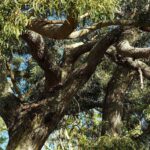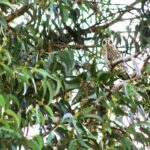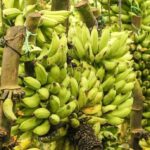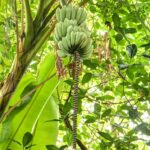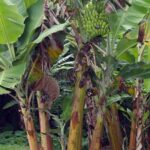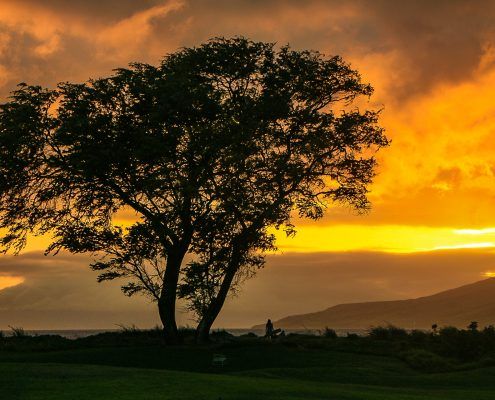
Trees of Maui & Hawaii
We Love Maui’s Trees!
We have always loved trees. Our Tour guides learn an incredible amount about Maui’s flora and fauna so they can answer all your questions correctly and in most cases they also have some interesting stories about them too! This is an invaluable learning experience as you can can always look up what kind of tree but to hear first hand the story of WHAT and WHY these trees are here and what they were used for in old Hawaiʻi makes it memorable.
Hawaiian Sandalwood
The Lost Ecosystem of Maui’s Ancient Forests
The story goes that the sandalwood trade began in the early 1800’s shortly after the discovery of the islands by Captain Cook. At that time the slopes of Haleakala from sea level to the tree line at about 8000’ elevation were completely covered by a 3 layered rainforest canopy of diverse trees of koa, ohia and sandalwood. The original Hawaiian sandalwood tree is believed to be root parasitic in that it grows and and spreads in association with other trees such as the native Koa and Ohi’a trees.
These trees created a dynamic forest which captured moisture coming off the ocean, creating it’s own cloud layer which fed a vibrant cloud forest. The forest captured rain that created the deep gulches and valleys of Haleakala’s leeward slopes. Native Hawaiians terraced these slopes to growing sweet potatoes and taro. The remnants of these terraces, many of which are overgrown with eucalyptus and other invasive species, can still be seen today
By 1811 trade ships began arriving regularly in Hawaiʻi and several sea captains were involved in a thriving sandalwood business with the Chinese. By trading shiploads of sandalwood for guns, cannons, ammunition and even western ships Kamehameha was able to acquire his own fleet of ships and modern armament he used to conquer all the islands, thus solidifying his rule which created the Kingdom of Hawaii. Kamehameha continued to trade with the British and Americans until his death in 1819. His son Liholiho (Kamehameha II) fell into debt with the westerners and the first general tax in Hawaiʻi was imposed…paid with sandalwood.
Kamehameha’s relationship with the British and the American traders may be why the Hawaiian flag is a combination of the Union Jack and red, white and blue stripes, thus appeasing both countries. The king was a shrewd and beloved leader who, by unifying the islands, brought peace to what some estimate was 100 years of war.
By 1830 the Sandalwood trade collapsed as the forests on every island were clear cut and even burned to find the last trees by smell. This deforestation resulted in the loss of all remaining seedlings and left only a few remote and inaccessible areas as the last remnants of a once great and expansive ecosystem.
Today the slopes of Haleakala are quite bare compared to ancient times but a new generation of conservationists are make great strides to restore Maui’s native forest. These reforestation projects hope to bring back much of the lost flora and fauna, including many endangered birds and insects. It is a herculean effort that will require many years of propagation and transplanting.
One of first zip-line courses in the country is in upcountry Maui. Skyline Eco-adventures started in 2002 and one of their goals as a company was and still is native reforestation. They have now planted well over 300 koa trees along the course and in 2010 they somehow got their hands on a sandalwood sapling. To see these trees in the ground is inspiring considering it has been close to 200 years since a sandalwood tree has been seen on this part Haleakala.
If you’d like to volunteer and restore some of this ancient ecosystem while on vacation visit our volunteer page.
Hawaiian Koa Trees
Lifeline of the Hawaiian People
The ancient Hawaiians had a connection with nature that was a large part of their survival and thus, their culture and beliefs. Rituals were performed and prayers given in the gathering of plants, birds and fish.
The Koa tree was sacred in ancient Hawaiʻi because it was one of the largest trees in the forest and was used to build the great voyaging canoes. The first surf boards were also made from Koa. Koa is endemic and can only be found in Hawaiʻi. The meaning of the word Koa in the Hawaiian language is brave, bold and fearless.
The Hawaiians saw all of nature as part of their spiritual life and even had a canoe deity or goddess which was the tiny ‘Elepaio bird (Flycatcher). They observed that if this bird pecked at a tree this meant it probably had worms and would not be good for canoe building. The Koa tree is one of the most amazing trees I’ve ever seen in a forest. Their roots develop nodules that harbor nitrogen fixing bacteria. As most trees spread pollen, Koa trees drop a powder like nitrogen onto their own roots to supply nutrients to the poor volcanic soil. They have a small white flower that looks like a tiny cotton ball which develops into a long flat pod.
Because there is no dormant cold cycle in Hawaiʻi, the Koa tree has no rings and therefore their age is often difficult to determine. Propagation has escalated in recent years as people now plant Koa trees in their yards as landscaping, mostly in the upcountry Kula area. Reforestation efforts have reintroduced the Koa into many parts of the upcountry area on the slopes of Haleakala. Skyline Eco Adventures and ʻUlupalakua Ranch continue to propagate and plant many of Maui’s native trees that were lost during the Sandalwood trade of the early 1800’s. It’s hard to imagine that Maui once had a three layer canopy rainforest of Koa and Sandalwood completely covering the slopes of Haleakala and the west Maui Mountains!
Found throughout Maui mostly in sea level forests, the Banyan tree is a spectacular and somewhat bizarre tree that has an interesting history in Hawaiʻi as well as in it’s homeland of India. It is a type of fig tree and as an epiphyte it starts it’s life in the crevices of a host tree. Sending out aerial roots down bark and to the ground they eventually engulf and crowd out the host. They are found throughout southeast Asia but in India the Banyan is the national tree and It is considered sacred because it represents eternal expansion. Among it’s many stories it is said that the god Krishna often rested in it’s branches as well as being the tree where the Buddha sat and contemplated mans existence which resulted in the birth of Buddhism. In the Nepal region it’s milky sap is used as a hair and skin conditioner and the roots are pounded to make a paste that is used to treat bruises and inflammation.
Hawaii’s most famous example is the Maui Banyan Tree found on Front Street in Lahaina. It is one of the largest of it’s kind in the world. In 1823 the Hawaiian Queens Keopuolani and Ka’ahumanu befriended the first American missionaries who arrived on Maui. These Queens were inspired to give them this beautiful area of Lahaina to build their coral and stone homes and buildings. Throughout this area of Lahaina can be found plaques which tell the stories of these missionaries and how they worked to help the Hawaiian rulers form a new nation.
This Banyan tree was brought to Lahaina from India in 1873 and planted for the 50th anniversary of the missionaries arrival on Maui and has been well taken care of for 140 years. In that time span it has grown from 8 ft tall to 60 feet high with branches that extend outward over 200 ft. These branches have stretched out from it’s huge core trunk and dropped aerial roots which developed into 12 separate trunks and shades about 2/3rds of an acre. This makes it a welcome resting place from the hot Lahaina sun. Many events and art exhibits are held under this Maui banyan tree and artist gather to sell their work every 2nd and 4th weekend of the month.
Banyan trees are also quite plentiful in lower parts of the West Maui Mountains as well as in the Hana area. A great example of this tree can be found along the path to the Pools of Ohe’o. The Pools of Ohe’o, also known as the Seven Sacred Pools, are a breathtaking natural wonder located in East Maui within Haleakala National Park. These mesmerizing tiered pools are formed by the cascading waters of the Ohe’o Gulch, creating a series of refreshing and inviting pools amidst lush tropical surroundings. Visitors can take a dip in the crystal-clear waters, marvel at the picturesque waterfalls, and soak in the serene beauty of the area. The Pools of Ohe’o are not only a popular attraction but also hold cultural significance as a sacred place in Hawaiian mythology. Exploring this enchanting destination is a must for nature lovers and those seeking tranquility in the heart of Maui’s stunning landscape.
Maui Fruit Trees
Canoe Plants of Polynesia
Polynesians voyaged across massive expanses of ocean in an ancient world where few civilizations ventured so far from land. Their range of exploration exceeded the total land mass of the earth. Scientist believe the Polynesian race originated in southeast Asia thousands of years ago and voyaged across the southern Pacific Islands colonizing well over 3000 islands. They were able to do this because they brought with them the plants and animals they would need to survive. The plants they brought with them from their home islands are known as “canoe plants” and included three types of fruit trees…
Maui fruit trees produce some of the tastiest tropical fruits you may ever encounter.
Scientists have found over 50 varieties of bananas growing throughout Hawai’i. Some have evolved over hundreds of years considering the first Polynesian immigrants arrived around 1000 A.D. This evidence shows how important banana’s were to the ancient voyaging Polynesians. Today even tastier varieties have been imported and cultivated on Maui to produce some of the best tasting bananas you may have ever had!
Banana Trees
Banana trees are one of the fastest growing plants in the world. On Maui if you have one in your yard it is always a treat to watch them bloom into a large bunch from a single flower. It can be tricky harvesting them though because a banana bunch can weigh as much as 50 pounds! For safety try to either tie them off with rope or have someone guide it down while you cut it off.
The tree will not produce another bunch so it must be cut off at ground level so that a new trunk can grow in order to produce another bunch. Usually there is no way to eat them all yourself before they rot so most people share them with friends and family as fast as they can. They’re so good it feels like a crime if you have to throw them out because they’ve turned black and soggy. There are plenty of places to shop for bananas on Maui. Some grocery stores like Safeway and Foodland carry local bananas but you’ll want to check to make sure as these stores also stock imported bananas from Mexico.
You will most likely find the ripest and sweetest ones at the many farmer’s markets and fruit stands along the road to Hana.
Banana trees are planted throughout Maui with several varieties producing amazing flavors not found anywhere else. However bananas are something the agricultural inspectors are always on the lookout for at airports and will confiscate them due to the possibility of contamination by fruit flies and several crop diseases present in Hawaiʻi. Plan on eating as much as you can while on the island. There are several large banana groves planted around Maui that supply local markets. Whether that translates into exporting them remains to be seen.
Our favorite and the most popular on the island are the Apple Bananas which are actually from Brazil. They are small (about 3-4 inches long) and have a light pink meat. Banana bread or muffins made from these bananas can change your life! Everyone has a favorite banana bread recipe but we love a variation which we like to make from the book “What Hawaiʻi Likes to Eat” that includes pineapple and orange juice. In case you would like to try making some yourself here is a great recipe and post about banana bread on Maui.
Coconuts
Another of Maui’s fruit trees that is seen and used as a food source is Coconut. Thoughts of Hawaiʻi invariably bring up the vision of coconut trees swaying in the sun on a beautiful sandy beach. Although they are an iconic symbol for the islands, there is a reason they are along most beaches.
It is said the first Hawaiians brought coconuts with them on their voyages from Polynesia. Coconuts are not indigenous to Hawaiʻi and it is hard to say exactly when they arrived in Hawai’i as they are well known for traveling great distances on the ocean currents.
The nuts are an amazing food source (with coconut water being a recent health food craze). Rope made from coconut fiber is incredibly strong and was used by ancient Hawaiians for construction of canoes, houses and weapons. They are especially tasty right off the tree and a fresh one can weigh as much as 8 to 10 pounds. You won’t see coconuts in the trees around resorts because they keep them trimmed off so they don’t fall on someone. We can remember camping in Hana and hearing them hit the ground like a bag of hammers, which is pretty spooky at night. We’ve heard marine biologists on Maui, in an attempt to quell people’s fear of sharks, point out that more people are killed worldwide by falling coconuts than by sharks.
Fresh off the tree they have a thick green wood pulp like husk that must be whacked off to get to the nut. Another favorite experience of ours was at a local private luau on the Big Island of Hawaiʻi where they had a trash can filled with fresh coconuts on ice. A guy would whack off the top of the green husk and nut in a couple precision strikes with a machete, dump some rum in it and hand it to you with a straw. Another well known desert in the islands is haupia which is a firm coconut pudding concoction. Sweet yet mellow. We could go on and on about stuff like candied coconut or the many fish dishes made with coconut milk we’ve enjoyed, but our best advice is to get your hands on a fresh one and anything else that’s “coconut kine” on Maui if you get the chance.
We just scratched the surface on the topic of Maui’s fruit trees but the best advice we can give people who visit Maui is to get your hands on some fresh fruit! It’s one of Maui’s true treasures.
Breadfruit Trees
Another plant brought to Hawai’i by the voyaging Polynesians is the breadfruit tree. This beautiful tree played a major role in colonizing the Pacific and was a key staple food. For hundreds of years before western contact with Hawai’i this fruit tree, called ulu, was a large part of the cultural and spiritual life of ancient Hawaiians. Ancient Hawaiian breadfruit groves were so large that some were capable of sustaining around 75,000 people! These trees were also an important source of wood, craft materials and medicines. Today few of the trees remain.
Breadfruit trees are one of the highest yielding food plants known. A single tree can produce between 50 to 150 fruits per year (yield varies between wet and dry areas) and their round, oval or oblong fruits can weigh as much as 12 pounds!
Breadfruit trees can grow to a height of 85 ft and all parts of the tree yield a latex sap which is useful as a sealant such as for canoe caulking. It’s light sturdy timber was used for canoe outriggers and house construction.
Maui’s Flowering Trees
Want to know more about flowering trees on Maui, like Jacarandas, Monkeypods and Plumerias? Check out this post all about it.
Rainbow Eucalyptus
Rainbow Eucalyptus trees are found on the road to Hana. See them on tour. We pass a number of groves where you can get out and experience these first hand. Learn more about these trees.

